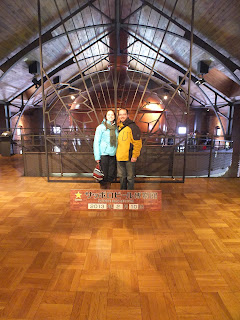For most Americans, when you hear someone say "Sapporo," you probably picture a tall, silver can with a little yellow star. Sapporo Beer is Hokkaido's ambassador to the world - one of Japan's beer mega-brands, along with Kirin and Asahi (and to a lesser degree, Suntory, which you rarely see outside of Japan).
 |
| You have a point, snowman - why not spend an afternoon at the beer museum? |
 |
| It's history and beer, all in one! |
 |
| An old mash tun. |
 |
| An restored stained glass window depicting Hokkaido-grown barley. |
 |
| The tasting hall. |
The original brewmaster was trained in Germany, and thus helped set the course of East Asian beer for the next 150 years - Sapporo is a big part of why East Asian beer is almost exclusively based on German recipes, whereas the beers in India and Southeast Asia are typically British in origin.
While the displays are mostly in Japanese, there's enough there for a visitor with a tiny bit of Japanese to piece together a rough history of the company.
 |
| Though there are a few more of these labels around than might be in good taste. |
The first exhibit included some really fascinating bottles from Sapporo-licensed breweries throughout Asia. It's the dark side of the history of Asian beer: the reason why Asian beer tastes like it does can be traced pretty much directly back to the Japanese Empire. Once Japanese soldiers developed a taste for beer in the 1880s, Japanese-style beer follow them into all the territories they occupied.
Of course, this being a Japanese museum, there had to be some elements of it that were simply inexplicable. Here, it was the Wonka-meets-Santa's-Workshop quality of the models depicting the brewing process.
 |
| I don't remember those other brewer tours having quite so many snowman-elves . . . |
But the posters were also a treat, tracing the broad trends of Japanese fashion and print culture over the decades. (These are roughly in order, from the late 19th century to the early 1980s. Apparently, I failed to take any pictures of anything later, though I remember some good ones.)
This gallery also included a small exhibit on Space Barley, a special-edition Sapporo brew made from barley grown on the International Space Station in 2006.
At about $100 a six-pack at its initial debut, it was one of the world's most expensive beers - and the best anyone could say about it was that it tasted pretty much like Sapporo. That was the point, though - to show that grains could be grown in microgravity without compromising their usefulness in a variety of food production processes.
Of course, like all good brewery tours and/or beer museums should, our tour ended in the tasting room, where we could sample a range of Sapporo offerings.
 |
| The onion beer cheese round failed to cleanse the palate. |
Plus, this being Japan, they had some stuff to stand in and/or stick your head through for silly photos.
Because you haven't really been there if you haven't taken a picture of your face shoved through a big sheet of particle board.






















